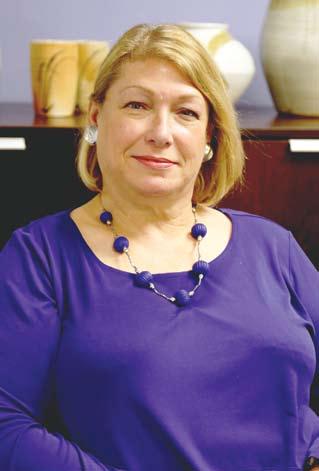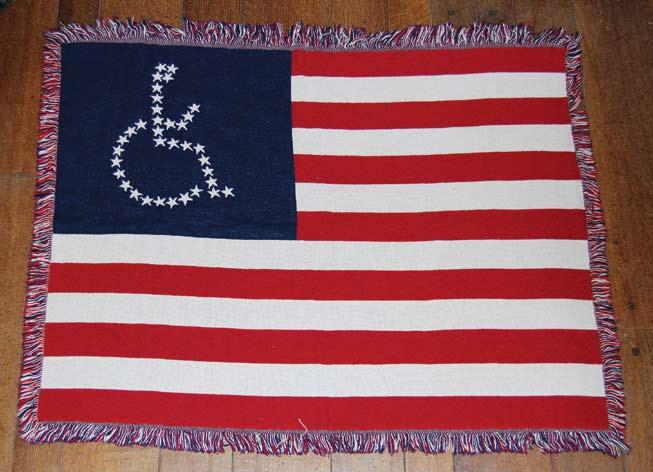
8 minute read
ARTS
Accessibility Insights
The Smithsonian’s director of accessibility explains an inclusive reopening strategy as the Americans with Disabilities Act turns 30.
Advertisement
By Jennifer Anne Mitchell
Contributing Writer JULY 26 MARKS the 30th anniversary of the signing of the Americans with Disabilities Act (ADA). The landmark legislation made it illegal to discriminate against people with disabilities, and established accessibility requirements for public accommodations (like retail stores and recreation centers), government services, facilities, transportation, and telecommunications. When President George H. W. Bush signed the bill in 1990, he said it “signals the end to the unjustified segregation and exclusion of persons with disabilities from the mainstream of American life.”
As the director of Access Smithsonian, the branch of the Smithsonian dedicated to disability and accessibility issues, Beth Ziebarth leads the country’s efforts to make museums inclusive.
Ziebarth herself is a wheelchair user.
“Civil rights are something that you have to protect,” she says.
Her office oversees policies, practices, and procedures; includes elements like sign language interpretation, captioning, and braille in museum offerings; and trains staff. Their guides on accessibility and inclusive design have been translated into multiple languages.
Access Smithsonian’s programs include Morning at the Museum, for families with kids who have disabilities, and Project Search, a job training program that places adults with intellectual and developmental disabilities in internships alongside classroom learning. Half of the program’s graduates have secured employment.
“That’s a pretty high percentage for people with this type of disability,” Ziebarth explains. “People with disabilities are underemployed in general, but [for] young people who have intellectual or developmental disabilities, it’s a really tough road.”
The coronavirus pandemic has led to some positive changes in accessibility, like online options for people who are unable to physically visit the museum. At the same time, new safety standards like no-touch options exclude some people with disabilities who rely on tactile experiences at exhibitions. Ziebarth and her team are advocating for inclusivity as the Smithsonian discusses how it will operate in a post-pandemic world.
City Paper spoke with Ziebarth to learn more about her and her work at this pivotal point.
This interview has been edited and condensed for clarity.
WCP: When did you get started advocating for accessibility and inclusion?
Beth Ziebarth: I was in a car accident when I was 16 and acquired a spinal cord injury—so that was my introduction to disability and accessibility. I started using a wheelchair and kind of made do as I went to college with accessibility, and the same thing in the first few years that I lived in D.C. [In] my early 30s, I [gained] more of a disability identity. I started working at the Smithsonian in 1988. I worked in two different parts of the institution before I worked specifically in the accessibility program [Access Smithsonian]. When the accessibility office was first formed, I helped the director to develop a baseline survey of the accessibility of the programming at the Smithsonian (exhibitions, public programs, publications, etc.). From there, when a position became available in 1995, I started working full time on accessibility.
WCP: What do you hope changes over the next 30 years?
BZ: I think there is still room in exhibition design and program design, and digital offerings, to increase access, particularly for people who have brain-based disabilities. That’s been an area where museums have more recently started to think about how well label content is understood by
Motoko Hioki
Beth Ziebarth different audiences and [consider] a multi-model approach— so if someone is more of a tactile learner that they can get information that way.
Personally, as a person with a disability and then also as a museum professional, I look at opportunities that we still have to increase the access to what we offer. But I also think about the original disability rights advocates who are now older after 30-some years. It’s really important for the younger generation of people with disabilities, what we call the ADA generation, people who grew up always experiencing accessibility in their lives, that the ADA generation knows their history and wants to protect it. That they feel the need to politically engage to make sure we don’t go backward.
WCP: What tip would you give people who are interested in learning about accessibility and inclusion?
BZ: I think that my best tip would be that you need to do the foundational work of accessibility, but you need to go beyond the bare minimums that are reflected in federal and accessibility standards. Go beyond that into inclusive design and thinking about how you can meet the needs of a full spectrum of visitors through your facility and program and digital offering design.
WCP: Can you speak more about the impact of disability representation from a museum angle?
BZ: I think that whenever a museum hopes to work with a community or an audience, it’s really key to not just be sitting in your office dreaming up a program and saying, “This will be the best thing for [them],” without having the input of the people you want to serve.
Museums have realized that for quite a few years now. But it feels like it’s only been relatively recently that we’ve really looked at that in terms of disability, too. Just like any other group of people, having stories in museums that reflect your lived experience is one of the reasons you visit a museum. You want to see yourself represented or your story reflected in history or culture or art or science. You want to think about disability as an identity in addition to posing an accessibility challenge to barriers like physical access, information access. You have to have both things: disability and accessibility as part of your inclusion equation.
WCP: The pandemic has changed the way our society operates. What positive changes in accessibility and inclusion have you seen during this time and what do you hope stays?
BZ: A good example of that is another program that we do called See Me at the Smithsonian for individuals with dementia and their caretakers. We’ve been doing the See Me program for two years, and then in the spring we started doing it online. It is actually really beneficial for a lot of our regulars who come to our See Me at the Smithsonian ingallery experiences at museums to have it online because they’re older adults, generally, and they’re vulnerable during a pandemic—even when we reopen—until we have a vaccine. There have always been issues of transportation and parking, and just moving around a museum can be a challenge.
So this has given us an opportunity to do programming that is reaching people in their homes at a time when they can’t go out. [It] relieves some of the isolation and gives the care partner and the person with dementia a very present moment. They don’t have to be talking about whether they finished all their lunch that day or finished their medicine or some of the medical aspects of dementia. It’s a moment in time when they can talk about art objects or things from the collection of American history. We will continue online after museums are open because we can do both and it will continue to reach a broad audience.
WCP: What role does technology play in your work?
BZ: I think that’s one of the things that, at the Smithsonian, all the museums are really focused on right now. We have a lot of digital interactives. We have a lot of touch screens. We also have mechanical interactives, where you spin a wheel or turn pages on a storybook, or tactile experiences.
Thinking about how technology can assist with the changes that feel necessary right now [during the pandemic]: You have to remind people to follow the protocol of wearing a mask, washing their hands, using the hand sanitizer, and social distancing. But on the technology side you can do things like for a touch screen, you can have a proximity sensor. The program will start playing because you’re in
9.875”

Universal Access Flag Lap Blanket by ADAPT, gift of Carol Jones proximity to the touch screen. So you remove the need to do touch. Or you can use different types of sensors, [like] hand gestures, that will initiate a program.
For people who are blind or have low vision, when they go to a museum, they can use a service called Aira Access where, through their smartphone, they connect to a live agent and the live agent uses a camera on the phone or your smart glasses to give you information based on what they see. So they can help guide you through the museum. They can even tell you about the objects that are on display. When you think about how important that is right now for the visitors, understanding the social distance that’s required, Aira’s one of the things that I think will be very useful for us.
WCP: Any other thoughts?
BZ: As we’re developing our reopening strategies and thinking about what the future of museums looks like, it’s really critical to listen to the voices of people with disabilities so that they don’t get left out in how we address kind of immediate needs of safety, with potentially shutting off some of the touch kinds of experiences in museums.
There’s the short-range strategy pre-vaccine and there’s the longer term post-vaccine. And we don’t want to go back to museums that are objects in glass cases without a lot of experiences and opportunities for visitors. We’ve worked too hard, not just for people with disabilities, but for all visitors, to make museums more welcoming than that. So we need to find that good balance between safety and also still being able to do experiential kinds of things at the museums.

DC Public Library
Phase 2 Reopen Services
Anacostia | Benning | Cleveland Park | Mt. Pleasant | Northeast | Shepherd Park | West End | Woodridge
Library Hours:
Mon – Fri: 11 a.m. – 7 p.m.
Closed for Daily Cleaning: 2 – 3 p.m.
Saturday and Sunday: Closed









